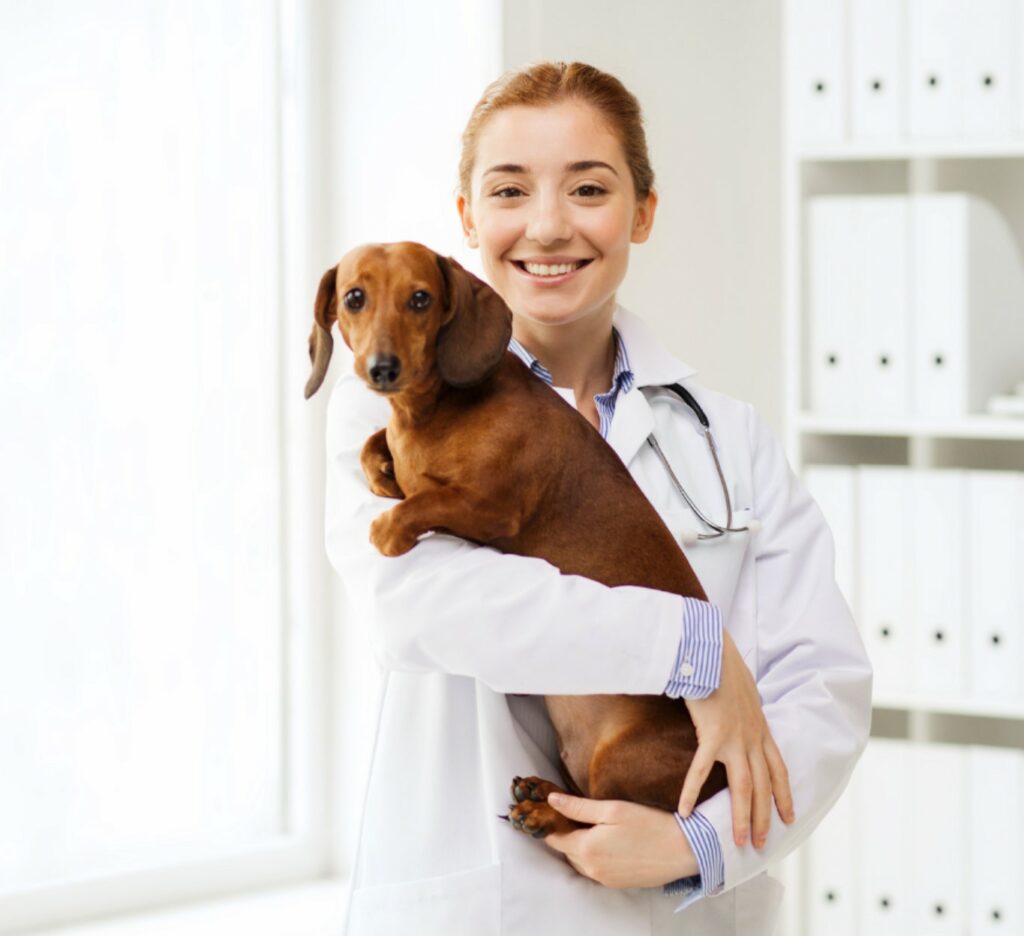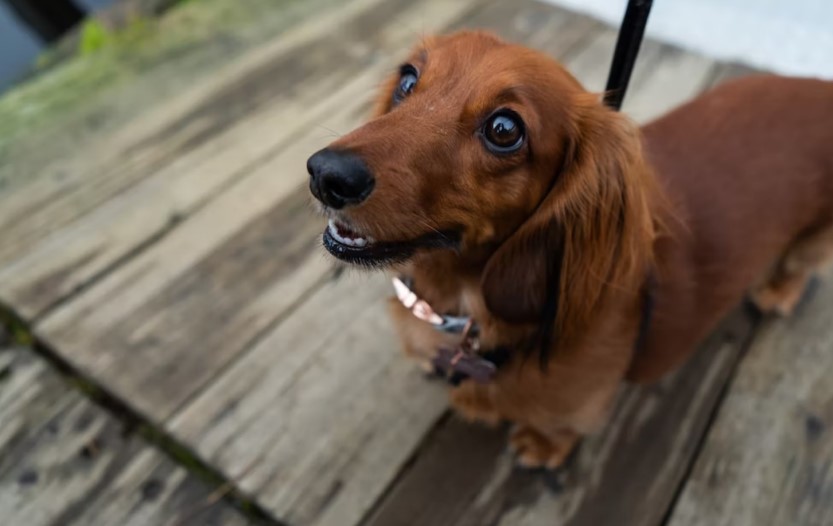Did you just notice your Dachshund’s back legs shaking, and you don’t know what’s going on its legs? Well, there are various reasons why your Dachshund might suffer from tremors.
For example, if your dog gets very excited, it might appear to have tremors. Tremors may also happen when they take toxic substances.
So what’s really going on? This article will provide you with all the possible conditions affecting your dog. Let’s dive in, shall we?
Why Is My Dachshund Back Legs Shaking?
Disk herniation could be the primary reason your Dachshund’s leg is shaking. It’s a condition where the supporting discs between the vertebral column bulge or move into the spinal cord space.
Below are some other problems that might be affecting your dog:
- Paralysis,
- Bone deformities
- Stressed joints
- Antebrachial growth deformity
- Elbow dysplasia
- Bowlegged syndrome
- IVDD
- Elbow dysplasia
- Injuries
What To Do If Your Dachshund’s Legs Are Shaking
When your dog is shaking uncontrollably and seems unable to walk, it’s not normal. It could be a sign that your dog may have some spinal problems.
If it seems like your Dachshund’s legs are affected, your dog might have a herniated disk or disk bulges in the vertebrae. This health issue can affect both the front and back legs.
To confirm this predicament, you can carefully observe how your dog’s legs work. Next, carefully locate the leg that does not seem to be working.
If the front legs are affected, it’s a sign that the slipped disk is located in the neck area. And if the back legs are affected, the slipped disk is located in the spine.
As a Dachshund parent, could you do your best to restrict their movement? Also, while trying to restrain them, call your vet. If you can’t get to them on time, call the emergency vet clinic and see someone as soon as possible.
Below are some of the questions your vet might ask you:
- The time you noticed this
- How it happened
- Which of the legs were affected (front or back)
- Possible symptoms
- How your dog acted when the first sign of pain occurred.
Often, when the legs are affected, It can be a sign of an Intervertebral Disc Disease (IVDD). It’s important to note that some vets are not fully aware of this disease.
So if you’re noticing some signs and symptoms of this disease, and your vet is not giving you the correct answers, you can pick another vet to take your Dachshund to.
Other Possible Reasons Why Your Dachshund’s Legs Are Shaking
Your Dachshund’s legs might be shaking due to an acute injury. Something might have happened to your dog when you were not around. Maybe it got hit by a car, fell down the stairs, fell when jumping, was stepped on, kicked, and more.
In these instances where your dog was injured or mistakenly had a back injury, this might be the cause. However, if your dog’s age is between 4 and 8 and was not injured, chances are this injury is caused by IVDD.

How To Know If Your Dachshund Has A Leg Problem
Often, you can tell by the position of your dog’s leg that something isn’t right. Now, the legs of Dachshunds are curved. But notwithstanding, you can still tell if your dog’s legs are not in the right place.
If you notice that your dog is walking differently, quickly go to your vet to check for any underlying health condition.
Sometimes the way your Dachshund stands can tell you if they have a problem with their legs. Once you notice any strange poses or movements, kindly take them to the vet.
If you pay attention to how your dog walks regularly, you will notice a change in its movement or behavior. Paying attention to these changes is one of the ways you can tell if something is wrong with their legs. Below are a few symptoms you should look out for:
- They’re not as playful as they used to
- Runs at a slow pace
- Stiffness within the legs, especially the hind legs
- Severe pain
- Swollen joints
- Strange behavior
- Reluctance to eat or play
- Head pulled in
- Arched backward
- Seems to be in pain when touched or picked up
- Difficulty in bending to eat or drink
- The back legs are dragging
When you notice these symptoms, quickly take them to the vet. In case of a ruptured disk, meeting the vet on time helps increase the success rate of fixing the problem by 90%. Your Dachshund will have to undergo surgery to repair the ruptured disk.
There’s a high probability that your dog’s legs will be restored in no time if you get it treated quickly. However, the success rate of this operation may reduce to 50% once complete paralysis sets in. it may even decrease to 5% when you, as a dog owner, choose to get surgery after 24 hours.
Common Leg Problems That May Have Affected Your Dachshund
Elbow Dysplasia
Elbow dysplasia happens when your Dachshund’s elbows are not formed correctly. The elbow consists of three different bones, and the dog’s weight will be uneven when there’s a deformity. It may even cause arthritis to set in.
Your Dachshund might need braces or other medical treatment for mild cases of elbow dysplasia. That said, sometimes, you may need to opt for surgery to deal with this problem effectively.
Luxating Patella
This health condition will affect your Dachshund’s Hind legs. It occurs when the patella or kneecap becomes displaced or misaligned.

You will quickly notice this when it happens to your dog. It would seem as if the kneecap is moving back and forth. It’s a sign that it’s dislocated and may cause other injuries. If care is not taken, it might also lead to arthritis.
You must get this treated immediately, as it will lead to surgery if not attended to immediately.
Bowlegged Syndrome
This bowlegged syndrome is prevalent in many Dachshunds. The back legs bend to the extent that the bones become deformed. The prominent bone affected by this syndrome is the distal tibia. As a result, the bone turns in towards the body.
This syndrome can be a very uncomfortable one for your Dachshund. Indeed, it’s a rare disease, and if you leave it untreated, your dog might have arthritis in the end.
This syndrome can be resolved with surgery or casting. So, once you notice that your dog’s leg looks strange, quickly rush your dog to the hospital.
Antebrachial Growth Deformity
This health condition is quite common among Dachshunds. When this happens, your dog’s front leg will grow larger than the back legs. This form of deformity will lead to some stress on your dog’s joints.
Their walks will be very uneven, and it may lead to some severe leg problems. To fix this disorder, your dog might have to go for surgery.
Bone Deformities
This deformity may happen in Dachshunds due to genetics and other health problems. Bone deformities can prevent the legs from working correctly.
One of these deformities includes the Pes varus. For this deformity, the distal tibia is turned inward toward the body.
Another one is Chondrodysplasia. In this case, the bones develop easy-westy feet, angular hock deformity, and more. These are diseases that will cripple your Dachshund in no distant time.
Paralysis
Sometimes even though you’ve done your best to be a good parent to your dog, it can still get a herniated disk. Now some dachshunds may react differently to paralysis.
However, once you notice that your dog is dragging its back legs, showing signs of paralysis, or seems to be in pain, it’s an emergency. You may need to visit the vet or emergency room immediately.
IVDD
As we earlier stated, IVDD occurs when a disc slips or is herniated, thereby forcing itself into the spinal canal. It may lead to pain, paralysis, muscle spasms, and incoordination.
Based on research, Dachshunds are 12 times more likely to get IVDD than other breeds of dogs.
Major Causes Of IVDD
One of the reasons why this intervertebral disease may occur is because of genetics. It may also happen due to jumping or excess pressure on the spinal cord leading to compression.
If it isn’t treated, it may restrict blood supply, and this may lead to more inflammation of the spine. Eventually, this may result in the complete paralysis of your dachshund dog.
Signs & Symptoms Of IVDD
Here are some signs that your Dachshund may have symptoms of IVDD. Please keep in mind that IVDD can happen slowly or suddenly. Let’s begin:
- Loss of appetite
- The bac slowly begins to arch
- Pain in the affected legs
- Legs are currently unable to hold the Dachshund’s weight
- Unable to stand for long
- The head gets lower when in a standing position
- Very sensitive when touched
- Walking in an uncoordinated manner.
- Tight abdomen
- Stiffness in the limbs or back
- Unable to stand straight
- Sways or falls suddenly when walking
- Muscle spasm
- Frequent urination
- Paralysis of the back legs
Please note that IVDD can be mild to moderate. At this point, your Dachshund may be able to move correctly but may have some slight pains. Other times, they may be sensitive when held or touched.
It can also be moderate to high. And this time, your dog will be frail and may not be able to hold its legs up. Sometimes they may be dragging their legs and shaking at the same time.
When the case goes from moderate to severe, your dog may be unable to stand or walk. It’s currently in excruciating pain and may be unable to support itself.
One problem with IVDD is that it may be tough to diagnose. It’s primarily due to other health problems happening at the same time. Hence, IVDD is misdiagnosed as muscle spasms, arthritis, problems with the stomach, and more.
This poor diagnosis will worsen your dog’s health and may lead to an extreme situation such as paralysis.
Stages Of IVDD
IVDD injuries occur in five steps:
- First stage: Signs of pain in the neck or back
- Second stage: Your dog can walk but may look very weak with little or no control of its body movement
- Third stage: Your dog is able to move the legs but unable to walk or even stand.
- Fourth stage: Your dog is not able to move its legs completely. It’s partial paralysis, but in this case, they can still feel it when their toes are pinched.
- Fifth stage: in this stage, your dog experiences complete paralysis. At this point, there is no feeling at all in the legs.
Can We Use Traditional Treatment For IVDD?
Problems with IVDD can always be resolved. However, it depends on how severe it is. For mild cases, home cures, vet cures, and sometimes pain relief could help. Below are some home cures you could use if your dog has IVDD:
- Confinement
- Massages
- Mild exercise.
- The use of anti-inflammatory drugs
- Cage rest.
Here are also some vet cures you could use:
- Hydrotherapy
- Freezing therapy
- Antibiotics
- Laser therapy
- Acupuncture
- Surgery
To manage the pain, here are a few things your Dachshund dog might need:
- Antibiotics
- Painkillers
- Anti-inflammatory drugs
- Non-steroidal Drugs
- Muscle relaxants
Ways To Prevent And Fix Your Dachshund’s Leg Problem

Dachshunds with these leg problems usually end up in the emergency room waiting for surgery. These surgery situations mostly happen when they’ve been left unattended for a long time. Now, there are some things you could do to prevent or fix this problem. They include the following:
- Make use of dog ramps
- Prevent your Dachshund from using the stairs, jumping on the furniture, or into cars
- Avoid any form of exercise that may be very demanding
- Avoid cross-breeding with dogs having leg or back problems
- ENSURE YOU USE Glucosamine or Chondroitin for cartilage health
Final Words
Dogs, especially Dachshunds, have been known to be perfect companions. If you notice that your Dachshund’s leg is shaking, in pain, or seems to have lost control of its legs, do something about it.
Overall, pay attention to the signs your dog is giving you. In that way, you can ensure that they remain healthy and pain-free.

